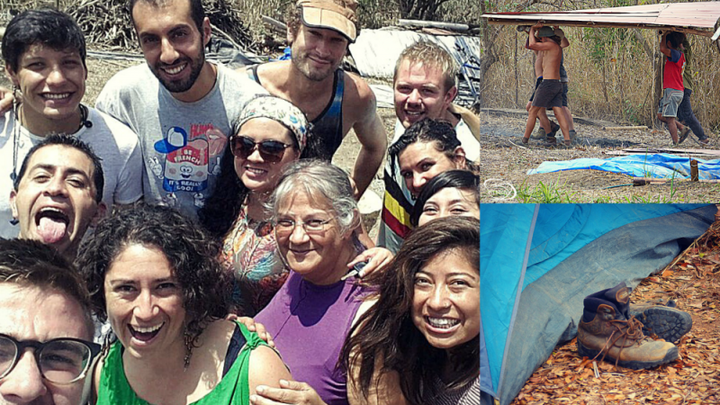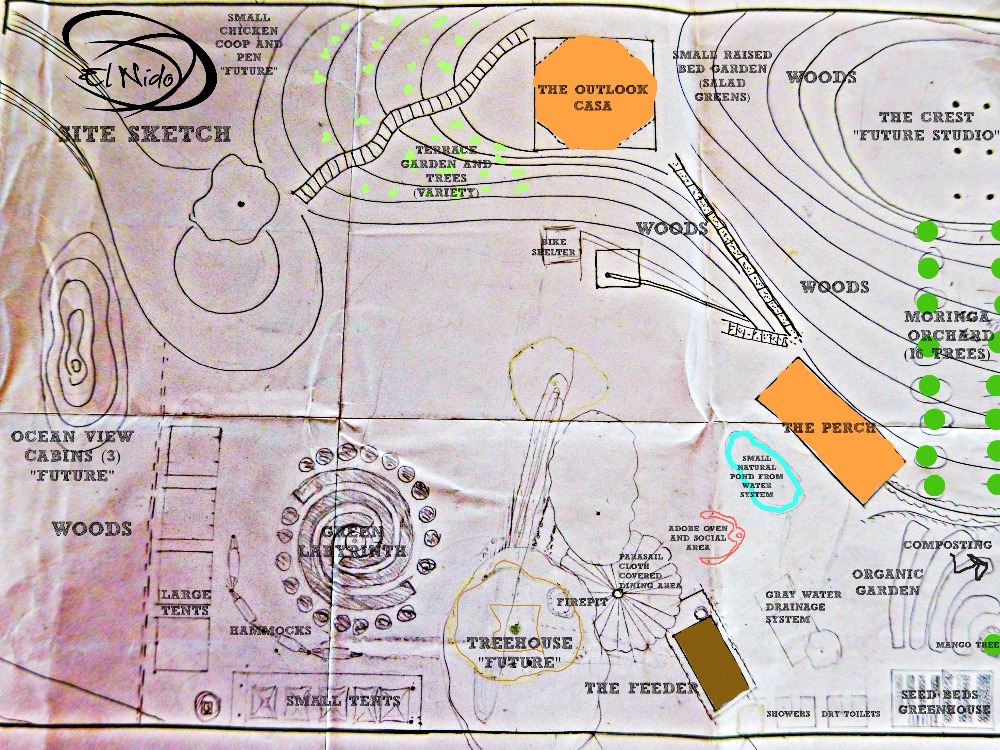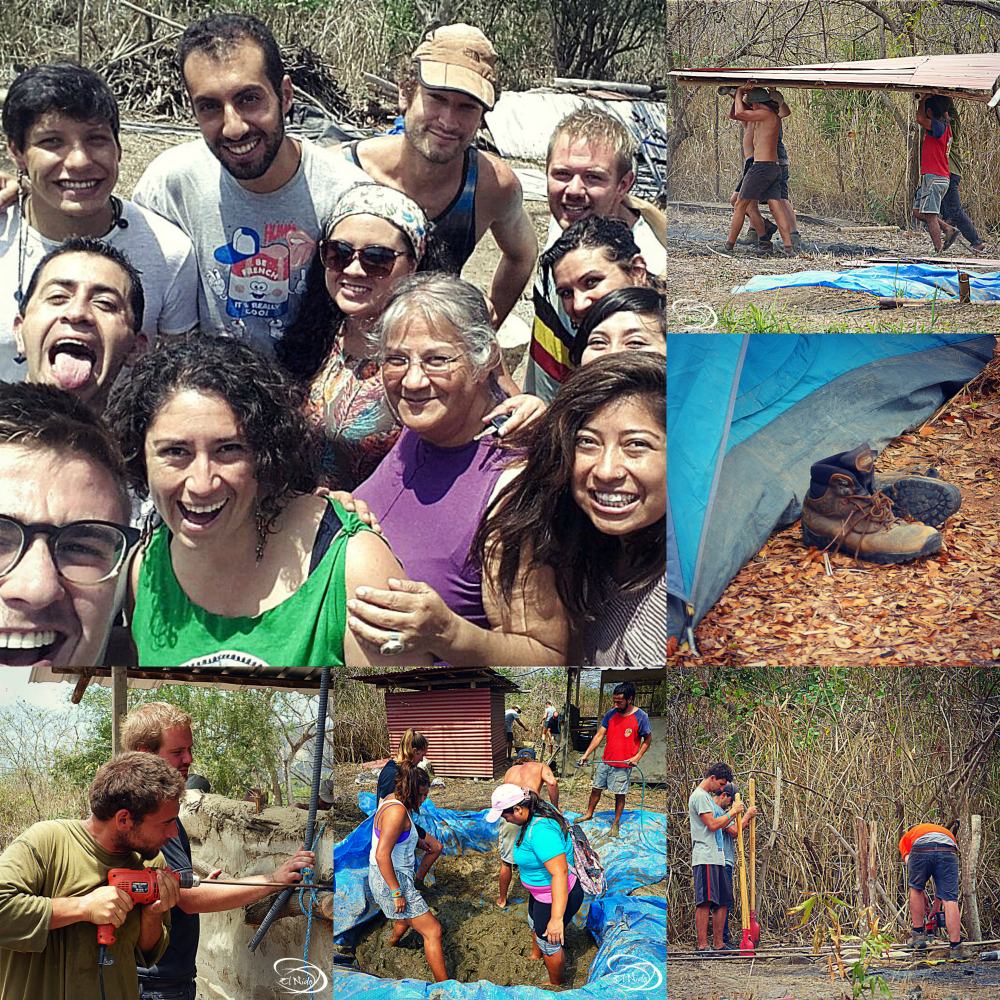
Help Volunteers Uplift Ecuador
Donation protected
After any disaster like April’s earthquake in Ecuador, there comes a time for partnership and consolidation. Because of this, one of the earthquake’s recovery projects, Proyecto Samán, is moving its volunteer, operational, and educational centers to the property of el Nido (the nest)—a small writers’ and artists’ retreat center I’m establishing near Canoa. (I’m doing this while simultaneously serving as Proyecto Samán’s Senior Advisor.) This move will further Samán’s efforts to rebuild the northern coast of Ecuador by allowing it to consolidate its resources.
Below I outline the components of Samán’s plan and explain why I need funding to cover the costs of housing them here at el Nido.
1. Volunteer Center
Volunteers will now be fed, housed, and based at el Nido—all in a communal, camp-like setting. In the aftermath of any disaster, volunteer labor is one of the most important and, thus, essential-to-sustain resources. Rebuilding cannot progress without those willing to work and without a way to feed and house those who have left personal economic security to serve at no cost to the recovery itself.
2. Operational Center
Because volunteers will be here, el Nido will become Samán’s operational base. This will include things like an office, meeting space, workshop, art studio, and secure storage. This location is essential because internet service is available in this part of Manabi Province . Since there is no WIFI or cell service available at the camp itself, operating an office from Samán is impossible.
3. Educational Center
El Nido will supplement the camp’s educational center by hosting workshops and livelihood training, especially those that require internet access. And since public transportation to and from the camp itself does not exist, families in the coastal area south of Canoa will be able to access training at a place served by local buses.
4. Project Modeling
El Nido will create and model permaculture, organic agriculture, and environmentally friendly design in a place with clear land tenure. These architectural models then can be implemented into the design of the Samán families’ permanent housing. El Nido has also begun worm farming as part of soil enrichment, allowing us to plan a small moringa tree orchard. The moringa , also known as the magic tree, is resource-dense and matures with a year’s growth, making it a sustainable source for nutritional supplements. Samán residents can not only participate in developing products from these trees, but they can also benefit economically by earning ongoing incomes from selling and marketing them.

Why we need YOUR HELP
Housing these Samán projects at el Nido costs money just to keep water flowing and the lights on. Imagine the water needed for a dozen volunteers to shower and cook. And we cannot pump cistern water without electricity. We cannot operate modems, routers, and computers or power tools like circular saws and drills. We can’t refrigerate food or illuminate the camp at night. Not to mention pay the rent.
We estimate the above costs to run about $500 a month—not much to keep all these projects up and running and our free labor force of 6 to 15 housed and happy—minimally comfortable, many in the same kind of tents which the Samán families themselves live in.
$500 x 12 months = $6000 for 2017!
Cultural Rational for this Partnership
Besides the fact that I am the Proyecto Samán’s senior advisor, it makes sense culturally to house these Samán projects on the el Nido property I’m developing.
El Nido is being established as a center for writers and artists, who can be inspired and sustained by the culture of volunteerism that will surround them at our creative retreat center.
There is always an overlap between volunteer and creative cultures. Both are fed by the same spiritual source and give back to the communities they serve. Creators are also servants—their paintings and poems, their novels and sculptures both give voice to human need and offer rich expressions of human diversity. Writers and artists narrate the human story—sometimes a story of disaster but often one of victory and triumph over adversity. Your contributions will also support these storytellers and monument-makers.
Why you?
We need you to also be a part of our story. Please help fund our continuing narrative of courage and success by making even a one-time gift or by making a monthly contribution. And if you can’t give financially, you can help us enormously by sharing our message with others, especially via social media.
It’s not only your financial contribution that matters but also your joining our voice and amplifying it to whomever you know.
Economic contributions, even the smallest ones, add up to make a big difference. Our volunteer and operational centers will not receive funds dedicated to other rebuilding and recovery efforts.
We have been blessed with volunteers and continue to need more. If you would like to learn how to become one, click here . So far, volunteers from four continents have donated their time and expertise. Perhaps you’d like to join them.
Thank you for all that you’ve done already. Our gratitude is enormous and our hearts go out to you in a warm embrace of appreciation. Thank you.
Blessings and peace to all of you from everyone here.
Sara Coppler
Senior Advisor for Proyecto Samán
and Caretaker at El Nido
(For more informtion on me, scroll below the photos)

"If you want to lift yourself up, lift up someone else."
~ Booker T. Washington
On my return to disaster response in Ecuador:
I moved to Cuenca, Ecuador several years ago to become an entrepreneur after more than 20 years of international development and disaster response work . With a background in architecture and study in Complex Disaster Management at Georgetown, I have lead cross-cultural teams in transformative development and disaster response projects in diverse settings in over 20 countries, including Afghanistan, Angola, Vietnam and Haiti.
I thought I was done with disaster relief work... until the earthquake rocked Ecuador on Saturday, April 19, 2016.
As a developing nation, Ecuador lacks the finances and experienced disaster relief personnel to manage this crisis alone. My phone starting ringing, people needed my expertise, and I felt led to contribute what I know to help.
I've moved to the coast to assist families in Canoa, Ecuador. As the senior adviser of Proyecto Samán working in tandem with several non-profit and volunteer agencies, we have created transitional shelter for people who are sleeping in make-shift environments after their coastal town was destroyed and are moving forward to developing permanent housing. We are also creating a model that other communities can use to house the thousands of newly homeless people all along the northern coast of Ecuador.
If you'd like to receive my monthly newsletter: Coastal Heartbeat: The Pulse of Recovery in Northern Ecuador -- just message me or click on Proyecto Samán for the latest website updates.
Below I outline the components of Samán’s plan and explain why I need funding to cover the costs of housing them here at el Nido.
1. Volunteer Center
Volunteers will now be fed, housed, and based at el Nido—all in a communal, camp-like setting. In the aftermath of any disaster, volunteer labor is one of the most important and, thus, essential-to-sustain resources. Rebuilding cannot progress without those willing to work and without a way to feed and house those who have left personal economic security to serve at no cost to the recovery itself.
2. Operational Center
Because volunteers will be here, el Nido will become Samán’s operational base. This will include things like an office, meeting space, workshop, art studio, and secure storage. This location is essential because internet service is available in this part of Manabi Province . Since there is no WIFI or cell service available at the camp itself, operating an office from Samán is impossible.
3. Educational Center
El Nido will supplement the camp’s educational center by hosting workshops and livelihood training, especially those that require internet access. And since public transportation to and from the camp itself does not exist, families in the coastal area south of Canoa will be able to access training at a place served by local buses.
4. Project Modeling
El Nido will create and model permaculture, organic agriculture, and environmentally friendly design in a place with clear land tenure. These architectural models then can be implemented into the design of the Samán families’ permanent housing. El Nido has also begun worm farming as part of soil enrichment, allowing us to plan a small moringa tree orchard. The moringa , also known as the magic tree, is resource-dense and matures with a year’s growth, making it a sustainable source for nutritional supplements. Samán residents can not only participate in developing products from these trees, but they can also benefit economically by earning ongoing incomes from selling and marketing them.

Why we need YOUR HELP
Housing these Samán projects at el Nido costs money just to keep water flowing and the lights on. Imagine the water needed for a dozen volunteers to shower and cook. And we cannot pump cistern water without electricity. We cannot operate modems, routers, and computers or power tools like circular saws and drills. We can’t refrigerate food or illuminate the camp at night. Not to mention pay the rent.
We estimate the above costs to run about $500 a month—not much to keep all these projects up and running and our free labor force of 6 to 15 housed and happy—minimally comfortable, many in the same kind of tents which the Samán families themselves live in.
$500 x 12 months = $6000 for 2017!
Cultural Rational for this Partnership
Besides the fact that I am the Proyecto Samán’s senior advisor, it makes sense culturally to house these Samán projects on the el Nido property I’m developing.
El Nido is being established as a center for writers and artists, who can be inspired and sustained by the culture of volunteerism that will surround them at our creative retreat center.
There is always an overlap between volunteer and creative cultures. Both are fed by the same spiritual source and give back to the communities they serve. Creators are also servants—their paintings and poems, their novels and sculptures both give voice to human need and offer rich expressions of human diversity. Writers and artists narrate the human story—sometimes a story of disaster but often one of victory and triumph over adversity. Your contributions will also support these storytellers and monument-makers.
Why you?
We need you to also be a part of our story. Please help fund our continuing narrative of courage and success by making even a one-time gift or by making a monthly contribution. And if you can’t give financially, you can help us enormously by sharing our message with others, especially via social media.
It’s not only your financial contribution that matters but also your joining our voice and amplifying it to whomever you know.
Economic contributions, even the smallest ones, add up to make a big difference. Our volunteer and operational centers will not receive funds dedicated to other rebuilding and recovery efforts.
We have been blessed with volunteers and continue to need more. If you would like to learn how to become one, click here . So far, volunteers from four continents have donated their time and expertise. Perhaps you’d like to join them.
Thank you for all that you’ve done already. Our gratitude is enormous and our hearts go out to you in a warm embrace of appreciation. Thank you.
Blessings and peace to all of you from everyone here.
Sara Coppler
Senior Advisor for Proyecto Samán
and Caretaker at El Nido
(For more informtion on me, scroll below the photos)

"If you want to lift yourself up, lift up someone else."
~ Booker T. Washington
On my return to disaster response in Ecuador:
I moved to Cuenca, Ecuador several years ago to become an entrepreneur after more than 20 years of international development and disaster response work . With a background in architecture and study in Complex Disaster Management at Georgetown, I have lead cross-cultural teams in transformative development and disaster response projects in diverse settings in over 20 countries, including Afghanistan, Angola, Vietnam and Haiti.
I thought I was done with disaster relief work... until the earthquake rocked Ecuador on Saturday, April 19, 2016.
As a developing nation, Ecuador lacks the finances and experienced disaster relief personnel to manage this crisis alone. My phone starting ringing, people needed my expertise, and I felt led to contribute what I know to help.
I've moved to the coast to assist families in Canoa, Ecuador. As the senior adviser of Proyecto Samán working in tandem with several non-profit and volunteer agencies, we have created transitional shelter for people who are sleeping in make-shift environments after their coastal town was destroyed and are moving forward to developing permanent housing. We are also creating a model that other communities can use to house the thousands of newly homeless people all along the northern coast of Ecuador.
If you'd like to receive my monthly newsletter: Coastal Heartbeat: The Pulse of Recovery in Northern Ecuador -- just message me or click on Proyecto Samán for the latest website updates.
Organizer
Sara Coppler
Organizer
Lexington, KY